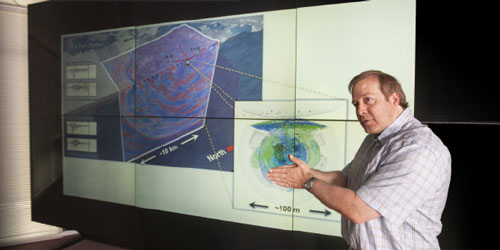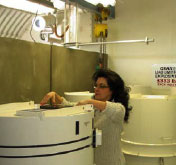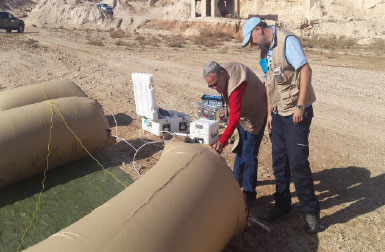Advancing Nonproliferation and Arms-Control Goals through Livermore Expertise and Technology
Laboratory experts use their knowledge of nuclear weapons, radiation detection, and safeguards to provide the nation with a crucial resource that enhances global security.
Relationship to the Laboratory’s Security Mission
Livermore’s program in nuclear nonproliferation and arms control (NPAC) draws on scientific, technological, and strategic expertise throughout the Laboratory to support the National Nuclear Security Administration’s (NNSA’s) Defense Nonproliferation Office of Nonproliferation and Arms Control. Our work in this area supports the Laboratory’s mission by addressing nonproliferation challenges through the development of innovative technical solutions that may prevent or mitigate potentially catastrophic incidents involving radiological, nuclear, or high-explosive materials.
From Policy to Technology
Livermore’s activities cover a spectrum of work, including supporting policy development, training experts, developing detection technology, and analyzing samples. NNSA’s Office of International Safeguards draws on the Laboratory’s technical resources to develop safeguards, policies, and approaches. Laboratory staff train experts within the U.S. and around the world for NNSA’s International Safeguards Engagement Program, demonstrating how to protect and manage dangerous materials, detect and control their illicit trafficking, and reduce proliferation risks overall.
Researchers at Livermore also develop technology for monitoring equipment, which NPAC uses in its support missions. For example, in its work for NNSA’s Office of Nuclear Verification (ONV), the Laboratory develops radiation-detection technology that is used to monitor arms-control agreements and assists ONV partnerships in the United Kingdom.
Livermore uses its analytical tools, in particular, high-precision mass spectrometry, to characterize uranium samples from various sources to develop forensic signatures that can assist the international nonproliferation community in identifying the source of illicit material in a shipment or device. Livermore's technologies and experts support ONV’s Nuclear Test Limitation Program as well as the Department of State’s (DOS’s) participation in Comprehensive Nuclear-Test-Ban Treaty enforcement activities,including on-site inspection exercises. The Laboratory’s researchers also support the DOS Office of Cooperative Threat Reduction with international engagement in nuclear security, nuclear forensics, and chemical and biological security.
Supporting Detection at the International Atomic Energy Agency
The Laboratory coordinates with NNSA to analyze samples collected by the International Atomic Energy Agency (IAEA). LLNL is one of four U.S. Department of Energy laboratories that analyze bulk environmental samples collected by the IAEA as safeguards. The agency created a network of analytical laboratories (NWAL) in the late 1990s to distribute the analytical burden (the other participants are Oak Ridge, Los Alamos, and Pacific Northwest national laboratories). Several international laboratories participate in NWAL, notably the IAEA’s Safeguards Analytical Laboratory in Seibersdorf, Austria. IAEA safeguards inspectors collect environmental samples at a facility and distribute them “blind” to NWAL for analysis.
IAEA’s goal is twofold: (1) verify that the safeguards declaration made by a particular facility is complete and accurate, and (2) detect undeclared activity. The isotopic composition and concentration of uranium and plutonium in these samples are the key signatures that safeguards evaluators use to meet these goals. It is impossible for a bad actor to mask the presence of plutonium in a facility. Discovery of uranium-235 enrichment levels greater than those allowed under the facility’s declaration is a smoking gun.
A Look Ahead
Livermore is continuing its work with NNSA, IAEA, and others to provide expertise and technical assistance, train experts, and develop and test new technologies to advance U.S. nonproliferation monitoring and arms-control treaty and agreement implementation.
One such technology is the Smart Sampler, a Livermore-developed system that autonomously captures subsurface gas from locations suspected of containing enhanced levels of noble gases. The presence and detection of significant levels of radioactive noble gases in the soil provides the highest level of certainty that an underground nuclear explosion has recently occurred. Another innovative technology is radiofrequency identification (RFID) tags for safeguards applications. The RFID technology permits detection, remote monitoring, and tracking of cylinders with nuclear materials, substantially improving monitoring efforts.
Nuclear security is a paramount responsibility and an ever-increasing challenge faced by the global community. Lawrence Livermore has a long history of studying nuclear debris and developing radiation-detection technologies and other diagnostics, stemming from decades of research and experience with nuclear weapons design and explosive testing. Today, Livermore’s expertise in this area is leading to innovative technologies that are improving our detection capabilities in support of the global community’s nuclear nonproliferation efforts. The Laboratory’s expertise is more relevant than ever with the expanding use and internationalization of nuclear technologies.







